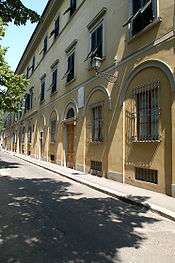Kunsthistorisches Institut in Florenz

The Kunsthistorisches Institut in Florenz (KHI) is one of the oldest research institutions dedicated to the History of Art and Architecture in Italy, where facets of European, Mediterranean and global history are investigated.
Founded in 1897 on the private initiative of a group of independent scholars, it has been under the auspices of the Max Planck Society since 2002. Approximately seventy scholars are currently employed at the Institute, which is run by two directors, and the promotion of international young academics is high on its internal agenda. In addition to numerous individual research projects, those funded by third parties and a multiplicity of international collaborations with universities, museums and research institutes, Kunsthistorisches Institut in Florenz provides a platform for larger long- and medium-term projects whose subject matter ranges from Late Antiquity to the Modern Age.
The Institute's resources, including the library with over 360,000 volumes, some of which are extremely rare, over 1,070 ongoing journal subscriptions, and one of the most wide-ranging photographic libraries on Italian art, are placed at the disposal of researchers from all over the world. With its programme of public academic events the Kunsthistorisches Institut in Florenz is a unique institution for international and interdisciplinary academic exchange.
History of the Institute
The idea of creating an art historical research institute in Florence is first discussed within a circle of academics, connoisseurs and artists gathered around the collector Baron Karl Eduard von Liphart.[1] In the winter semester of 1888/89, August Schmarsow, professor of art history at Breslau, teaches courses at various locations in Florence. Schmarsow may be considered the prime initiator of the Kunsthistorisches Institut in Florenz.[2]
Library
The library's books were removed by the Germans during World War II. After the war, many of the major collections looted from Italy were identified by the Monuments, Fine Arts and Archives service of the American military government and returned to their owners. The Collegio Rabbinico Italiano, the Kunsthistorisches Institut in Florenz, and the Deutsche Historische Bibliothek Rom were all returned, although not all were intact, to their owners in Italy. "These last two collections were seized by Hitler with the idea of re-establishing them in Germany."[3]
There is a photograph in the National Archives and Records Administration showing the unloading of some of these re-captured books. The caption reads: "The Kunsthistorisches Institut in Florenz, Library, is being unloaded at the Offenbach Archival Depot 9 July 1945. Three freight cars, 578 cases of books and catalogs of paintings, were brought from the Heilbronn salt mine in Württemburg-Baden where they were kept since brought from Italy."[4]
References
- ↑ http://www.khi.fi.it/history
- ↑ Hans W. Hubert: Das Kunsthistorische Institut in Florenz, Il Ventilabro, Firenze, 1997, S.12
- ↑ Posté, Leslie. 1948. "Books Go Home" Library Journal. 1 December 1948, page 1704.
- ↑ Pomrenze, Seymour. The records of the Offenbach Collecting Point for books and library collections are in the Ardelia Hall Collection, Boxes 250-262, OMGUS, Record Group 260, National Archives at College Park, MD.
External links
Coordinates: 43°46′38″N 11°15′50″E / 43.7772°N 11.2640°E
